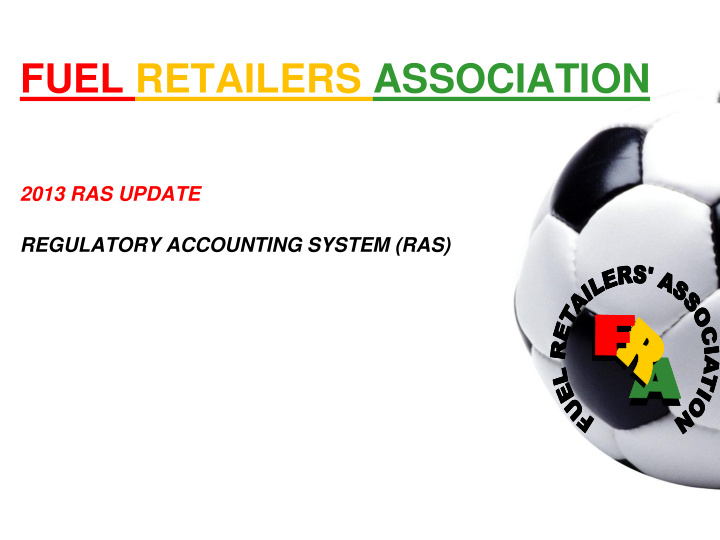



FUEL RETAILERS ASSOCIATION 2013 RAS UPDATE REGULATORY ACCOUNTING SYSTEM (RAS)
DECEMBER 2012 ADJUSTED RAS FIGURES Current Margins Build-up Post RAS Margins Make-Up Staff Related 42.0 Costs [60%] 69.4 69.4 Retail Margin [ 99.2] Other Retail Margin Expenses 27.4 [ 130.1] [40%] Entrepreneurial 18.8 18.8 Margin [18.8] 11.0 11.0 Retail cpl Investment 41.9 Margin 30.9 [41.9] cpl 58.0 Wholesale Wholesale Margin 27.1 Margin 15 Secondary Storage Service 25.5 Differential Secondary Distribution 10.5
What is hindering implementation Introduction of RAS has come with a number of challenges and the impact has been limited by an incomplete or half-hearted implementation of the system. RAS has resulted in the proper isolation of profits relating to retailing from the wholesale margin BUT the wholesalers, through unfair contracting practices, are still incorrectly enjoying this profit, and indirectly contradicting Section 2A(5)(a) of the Act. Wholesalers, through rental charges and franchising agreements are in fact directly benefitting from the retailing operation. Profits accruing to wholesalers from retail assets are nothing but a “ business practice, method of trading, agreement, arrangement, scheme or understanding which is aimed at or would result in a licensed wholesaler having a significant share in the retailer margin .” Therefore the Spirit of RAS has been completely ignored by some stakeholders for whatever reasons F UEL RETAILERS ’ ASSOCIATION Mr. Reggie Sibiya
What are the key implementation issues 1. RAS Principles from DOE not agreed/implemented by all parties ( principles informs the spirit of RAS in the absence of regulation) 2. Lack of regulation around elements of the Retailer Margin 3. Entrepreneurial Compensation now up for grabs ( not acceptable from FRA’s position) 4. Oil Companies wanting to claim more than what the model has allocated per asset or expense ( FRA’s view is that any party that claims under recovery on their asset or expense must approach the regulator and not claw the under recovery from the Entrepreneurial Margin) 5. Interpretation of the interim vs. post RAS dispensations. 6. No commitment to the Spirit of RAS 7. No commitment to a simple principle – who ever owns the asset, gets the return, whoever incur the expense gets the recovery portion allocated. 8. Lack of the overall bigger picture or blatant ignorance of the Regulator’s intentions by some parties F UEL RETAILERS ’ ASSOCIATION Mr. Reggie Sibiya
RAS PRINCIPLES To ensure a smooth transition to the end game( not just post RAS): 1. Maturity of the stakeholder engagements to avoid over regulation 2. Who ever owns the asset gets the return and whoever incur an expense receives the compensation as per the RAS Matrix. 3. Use of Capital Asset Pricing Model (CAPM) to determine the required return on equity has proved to be difficult and maybe inappropriate methodology for the current vertically integrated South African Market. However the existing structure from DOE (regulator) on the split of the returns for each activity to accommodate vertical integration remains until DOE advices of any changes F UEL RETAILERS ’ ASSOCIATION Mr. Reggie Sibiya
RAS is part of the Bigger Picture Encouraging appropriate investments in local petrochemicals sector Preservation of industry jobs in line with the national government agenda Encouraging SMME participation in the sector The EWP envisaged “ the preservation of retailing activities for small and medium businesses ” and the “ preservation and promotion of formal sector employment .” To give effect to this EWP policy statement, certain prohibitions relating to the sale of petroleum products were included in the Act, namely a prohibition on vertical integration in the petroleum industry
Recommend
More recommend